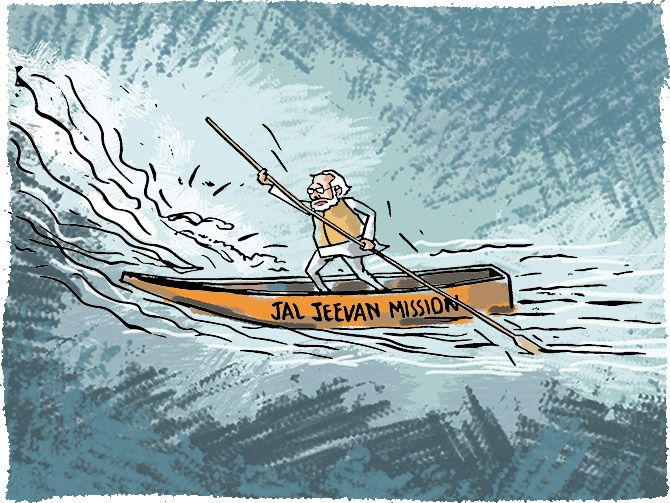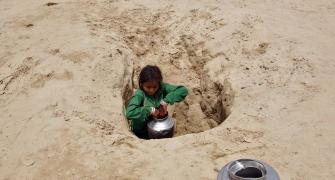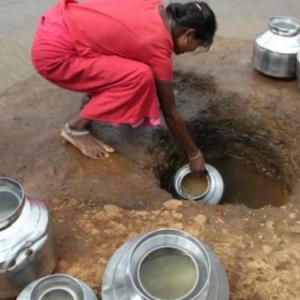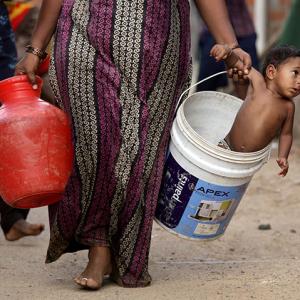'The Jal Jeevan Mission would require services ranging from groundwater recharge, pumping, small-scale water treatment facilities, piping, metering for flow/usage measurement, and most importantly, training and communication of local communities, and social and environmental audit of projects.
'This is precisely where the Rs 3.5 trillion needs to be be spent in the next five years,' says Abhishek Waghmare.
Illustration: Dominic Xavier/Rediff.com.

Multiple cities in the country are slated to “run out of water” in a decade.
In villages, too, the situation is grim: Less than half of the population can barely use 50 litres of water per day, India’s national auditor told the Parliament in 2018.
But how easy -- or difficult -- it is to provide water to all households?
Prime Minister Narendra Modi has said the Jal Jeevan Mission would require Rs 3.5 trillion over the next five years to implement.
This is fairly in line with the assessment of the Comptroller and Auditor General of India, which had estimated a spending of Rs 23,000 crore per year, from 2018 till 2030, roughly equaling Rs 3 trillion in current price terms (2018).
To complete the mission in five years, more would be needed: nearly Rs 70,000 crore a year, equivalent to 1.5 per cent of budgetary expenditure of Centre and states put together, or nearly 0.3 per cent of India’s gross domestic product.
This huge fund requirement comes at a time when the CAG report has flagged the falling expense on the National Rural Drinking Water Programme: It halved under the previous Modi government. While Rs 10,500 crore was spent in 2012-2013, a year when another wave of slowdown had hit the economy, the year 2015-2016 saw Rs 4,370 crore spent on the water programme.
But the magnitude of the task at hand does not end with financial issues, but starts afresh at how little pumping money into water supply has actually achieved. This article focuses on rural water supply, leaving urban issues apart, due to (non) availability of data.
'The overall coverage of rural habitations (getting 40 litres per day per person) increased only by 8 per cent, after incurring an expenditure of Rs 81,168 crore during 2012-17,' the CAG report noted.
If we consider that India has 169 million rural households (according to Census 2011), the Jal Jeevan Mission would require providing piped water to nearly 135 million households (barring the 17 per cent that already has it) in five years, or 90,000 households a day -- a mammoth task.
The story does not end here.
About 88 per cent of rural India’s drinking water is catered to by groundwater, wherein lie two major issues: Availability or quantity of water, and water quality.
In terms of quantity, more than 37 per cent of blocks (smaller building blocks of districts, totalling 6,880) have groundwater levels ranging from critical to over-exploited, meaning, risk prone. The most risky blocks are concentrated in a few states like Rajasthan, Punjab, Haryana, and Tamil Nadu.
Then, about 20 million people (17,800 habitations) live in areas where groundwater has been affected with arsenic contamination, while another 10 million (12,400 habitations) live in areas where fluoride contamination is rampant.
More than 400 habitations, mostly in Punjab, have uranium-contaminated water. Salinity is also a normal feature of groundwater in many over-exploited blocks, experts note.
Apart from water provision, the Jal Jeevan Mission needs to ensure availability and quality of water. This was aptly put forth by none other than the secretary at the new Jal Shakti ministry.
'The strategy so far to increase access to household water supply faced obstacles, including not paying enough attention to sustaining or recharging groundwater, the primary source, and treating service delivery primarily as an engineering solution, without adequate involvement of the users,' Parameswaran Iyer wrote in a column in Indian Express, after Modi announced the intent to roll-out the scheme. He was unavailable for comment.
Water expert Indira Khurana said that this would not be possible unless we “rebuild our relationship with water”.
“Water is a product of land, forest and ecology. Mere recharge might not solve the problem of availability and supply. An ecological approach is a must,” she said.
Taking all of this into account, the Jal Jeevan Mission would require services ranging from groundwater recharge, pumping, small-scale water treatment facilities, piping, metering for flow/usage measurement, and most importantly, training and communication of local communities, and social and environmental audit of projects.
This is precisely where the Rs 3.5 trillion would be spent, in the prescribed period.
With a slowing domestic economy, global headwinds, and limited fiscal room at the domestic (union and states) level, many experts say the mission would not be successful without private participation, or funding from corporate houses.
A 2013 Master Plan by the Central Ground Water Board had projected the estimated cost to recharge all critical groundwater areas (nearly 11 million) at less than Rs 80,000 crore (at 2011 prices). Assuming this cost must have doubled over a decade due to inflation (rise in prices) and growth in rent/wages, just recharging available sources would probably eat up nearly half of the Rs 3.5-trillion spending.
Part of this spending, and labour work, would be done through Mahatma Gandhi National Rural Employment Guarantee Scheme. This would ease the burden of the fiscal cost to some extent.
“Unless people are a part of it, this mission would not succeed,” Khurana said.










